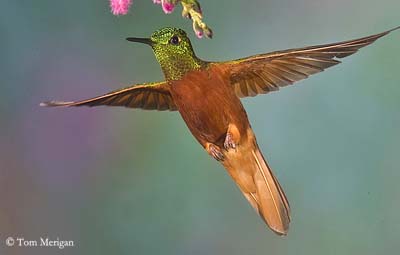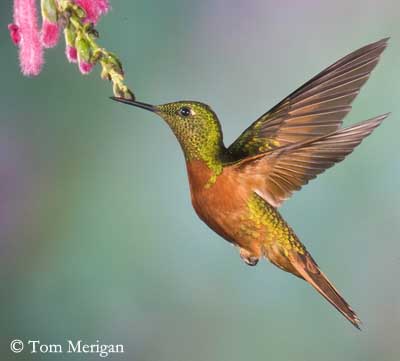
Fr: Colibri de Matthews
All : Rotbauchkolibri
Esp: Colibrí Pechirrojo
Ital: Colibrì diadema pettocastano
Nd: Matthew-hoornkolibrie
Photographer:
Tom Merigan
Tom Merigan’s Photo Galleries
Text by Nicole Bouglouan
Sources:
HANDBOOK OF THE BIRDS OF THE WORLD Vol 5 by Josep del Hoyo-Andrew Elliott-Jordi Sargatal - Lynx Edicions - ISBN: 8487334253
A GUIDE TO THE BIRDS OF COLOMBIA by Steven L. Hilty and William L. Brown - Princeton University Press – ISBN 069108372X
Chestnut-breasted Coronet
Boissonneaua matthewsii
Apodiforme Order – Trochilidae Family
BIOMETRICS:
Length: 12 cm
Weight: 7-8 g
DESCRIPTION:
Both sexes are similar.
Adult male has metallic green upperparts, head and gorget. Central tail feathers are coppery-green to bronze-green, and others rectrices are rufous, edged and tipped bronze-green.
Underparts are chestnut-rufous, including underwing and undertail feathers.
The head is metallic green. The bill is rather thick and straight. Eyes are dark brown. Short legs and feet are pale pink. Pale cinnamon tufts are almost invisible on the legs.

Female is similar with some cinnamon speckles on the green throat.
Immature shows more green areas on the underparts. On the upperparts, and mainly on the rump, feathers are edged cinnamon. It can breed in second year.
VOICE: SOUNDS BY XENO-CANTO
Chestnut-breasted Coronet utters high-pitched chirps and whistles. The short calls are given by both sexes from perches, and indicate the feeding territory.
Some aggressive, rapid chattering is uttered as chase call in defence behaviour.
Alarm calls are very shrill and often accompany flight attacks.
The song is short and made of monosyllabic sounds.
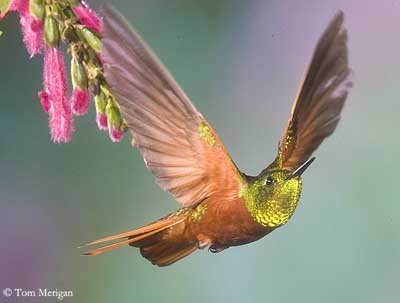
HABITAT:
Chestnut-breasted Coronet frequents the canopy of humid forest up to 2000 metres of elevation, sometimes higher, up to 3000 metres in Peru.
This species prefers to live inside the forest, and it is less seen at edges or more open vegetated areas.
RANGE:
Chestnut-breasted Coronet occurs in the Andean forests of extreme SE Colombia, Ecuador and Peru.
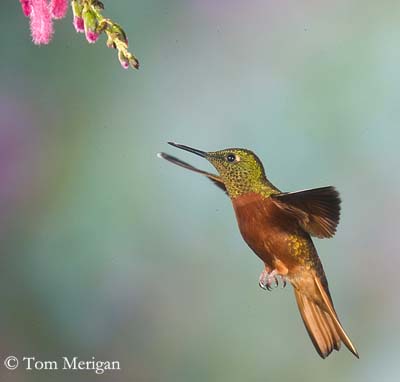
BEHAVIOUR:
Chestnut-breasted Coronet feeds on nectar at canopy level. These birds establish foraging territories around the clusters of flowers and defend them.
When they are feeding at flowering trees, several birds can sometimes forage together. They often cling to the flowers to feed easily.
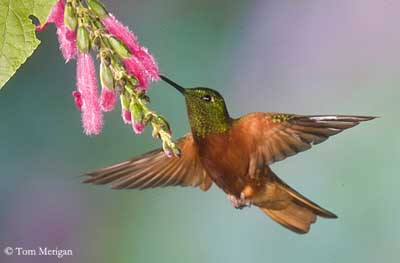
Chestnut-breasted Coronet also hawks flying insects from high perches, taking flies and wasps.
All the members of this genus are territorial and highly pugnacious. They defend strongly their nectar resources from perches on high exposed branches.
If a predator or an intruder approaches, the birds utter vocal warning signals and perform aerial diving attacks. Physical combat can occur during which the birds are locked in claw grips and then, they fall dawn to the ground.
Chestnut-breasted Coronet is sedentary within its range.
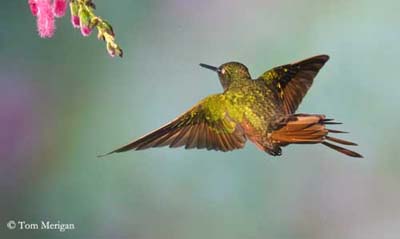
FLIGHT:
Chestnut-breasted Coronet, as other Trochilidae species, performs hovering for feeding at nectar sources and flowers. It can hover forwards and backwards with rapid wing beats.
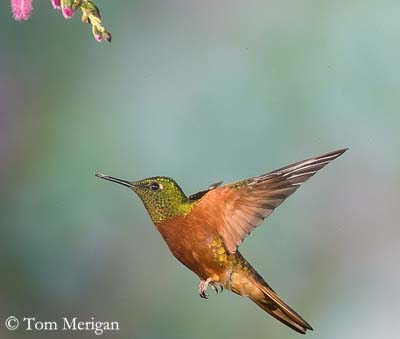
REPRODUCTION:
The nesting behaviour of the Chestnut-breasted Coronet is poorly known.
The nest is a cup made with moss and lichens.
Female lays two eggs and incubates alone.
DIET:
Chestnut-breasted Coronet feeds mainly on nectar from flowers. It also hawks flying insects such as flies and wasps.
PROTECTION / THREATS / STATUS:
Chestnut-breasted Coronet is fairly common within its range. The usual predators are mainly snakes and birds of prey.
